
Indoor plant owners often struggle with knowing when to water their plants. Without the ability to communicate their needs, it’s important to look for signs that indicate your indoor plant is in need of water.
By understanding the signs revealed in this article, you can ensure your plants stay healthy and hydrated.
Key Takeaways:
- Wilted or drooping leaves may indicate the need for water.
- Lighter soil color can be a sign of dehydration in indoor plants.
- Curling or brown leaf edges may suggest that your plant is underwatered.
- Checking the soil moisture regularly is essential for maintaining plant health.
- Observing your plant’s behavior can provide valuable insights into its watering needs.
Importance of Proper Watering for Indoor Plants
Proper watering is crucial for the health and well-being of indoor plants. When it comes to watering, finding the right balance is essential. Both overwatering and underwatering can have detrimental effects on plants.
Overwatering can lead to root rot, a condition where the roots of the plant become waterlogged and are deprived of oxygen. This can result in wilting, yellowing leaves, and even death.
In addition to root rot, overwatering creates the perfect environment for fungal diseases to thrive. The excess moisture provides a breeding ground for mold and mildew, which can attack the leaves and stems of the plant.
On the other hand, underwatering can cause dehydration and stunted growth. When a plant doesn’t receive enough water, it struggles to absorb nutrients from the soil and transport them to its various parts. This can lead to leaf discoloration, curling or wilting, and a general decline in the plant’s overall health.
To ensure the optimal health of your indoor plants, it is important to understand the signs of both overwatering and underwatering. By observing the behavior of your plants and regularly checking the moisture levels, you can provide them with the right amount of water they need to thrive.
Effects of Overwatering and Underwatering on Plants
| Effects of Overwatering | Effects of Underwatering |
|---|---|
| Root rot | Dehydration |
| Fungal diseases | Stunted growth |
| Yellowing leaves | Leaf discoloration |
| Mold and mildew | Curling or wilting |
Checking Moisture Levels
In order to determine if your indoor plants need water, it is important to check the moisture levels of the soil. There are several methods you can use to assess the moisture content and ensure your plants are receiving the proper hydration.
Method 1: Finger Test
The finger test is a simple and effective way to check if your plants need watering. Insert your finger into the soil about 2-3 inches deep. If the soil feels dry to the touch, it is time to water your plant. If it still feels moist, you can hold off on watering for a little longer.
Method 2: Soil Stick or Wooden Dowel
Another method to determine soil moisture is by using a soil stick or a wooden dowel. Insert the stick or dowel into the soil and leave it for a few minutes. When you remove the stick, observe if it comes out damp or dry. If it is dry, it is time to water your plant.
Method 3: Visual Signs
Aside from physical tests, you can also look for visual signs that indicate your plant needs water. Drooping leaves and a lighter soil color are common indicators of dehydration. If you notice these signs, it is a good idea to water your plant and provide it with the necessary hydration.
Moisture Levels Chart
| Moisture Level | Description |
|---|---|
| Dry | The soil feels dry to the touch and crumbles easily. |
| Slightly Moist | The soil feels slightly damp but not wet. |
| Moist | The soil feels moist and slightly sticky. |
| Saturated | The soil feels wet and waterlogged. |
Observing Plant Behavior
When it comes to ensuring the health and well-being of your indoor plants, observing their behavior can provide valuable insights into their watering needs. By paying close attention to how your plants look and behave, you can become attuned to their signals for hydration. Here are some common signs of dehydration in indoor plants to watch out for:
- Wilted or drooping leaves: When an indoor plant is in need of water, its leaves may appear wilted or droopy. This is a clear indication that the plant is not receiving enough moisture and is in need of watering.
- Lighter soil color: Another visual cue that your plant needs water is a lighter soil color. Dry soil tends to have a lighter, duller appearance compared to well-watered soil. Take a close look at the color of the soil in your plant’s pot to determine if watering is necessary.
- Curling or brown leaf edges: Dehydration can cause the edges of a plant’s leaves to curl or turn brown. If you notice this symptom, it’s a sign that your plant is not getting enough water and needs to be hydrated.
By observing these behaviors and signs of dehydration, you can take proactive steps to ensure your indoor plants receive the proper amount of water. Regularly check on your plants’ appearance and make adjustments to your watering routine accordingly.
Remember that different plant species may have varying watering needs, so it’s important to research the specific requirements of each plant in your collection.
Additionally, it’s worth mentioning that while observing plant behavior is a helpful method for determining watering needs, it should be used in conjunction with other assessment techniques, such as checking moisture levels and using weighing techniques.
By combining these methods, you can develop a holistic understanding of your indoor plants’ hydration requirements and ensure their overall health and vitality.
Table: Signs of Dehydration in Indoor Plants
| Signs of Dehydration | Explanation |
|---|---|
| Wilted or drooping leaves | Indicates lack of water uptake, resulting in loss of turgidity. |
| Lighter soil color | Dry soil appears lighter and duller compared to well-watered soil. |
| Curling or brown leaf edges | Result of water stress and insufficient moisture reaching the leaf margins. |
Weighing and Lifting Techniques
When it comes to determining if your indoor plant needs water, weighing and lifting techniques can provide valuable insights. By using the weight of the plant and pot, you can gauge the moisture content of the soil.
To determine if your plant needs water, try lifting the pot. A dry plant will feel lighter, indicating that it may be in need of watering. On the other hand, a well-watered plant will feel heavier due to the moisture in the soil.
This technique is especially useful for larger pots and plants that are harder to reach for other methods of assessment. By lifting the pot and comparing its weight to your previous experience, you can develop a sense of how heavy a well-watered pot should feel.
Remember to lift the pot with care, supporting the base to prevent any damage to the plant. This technique should be used in conjunction with other methods, such as checking soil moisture and observing plant behavior, to ensure accurate watering practices.
Table: Weighing and Lifting Techniques
| Plant Weight | Pot Moisture Level | Watering Recommendation |
|---|---|---|
| Lighter than usual | Dry | Water the plant |
| Heavier than usual | Moist | Avoid watering |
Using weight as a tool for assessing watering needs adds an additional layer of understanding to the care of indoor plants. By incorporating this technique into your routine, you can confidently provide the right amount of hydration to keep your indoor plants thriving.
Benefits of Using a Moisture Meter for Indoor Plants
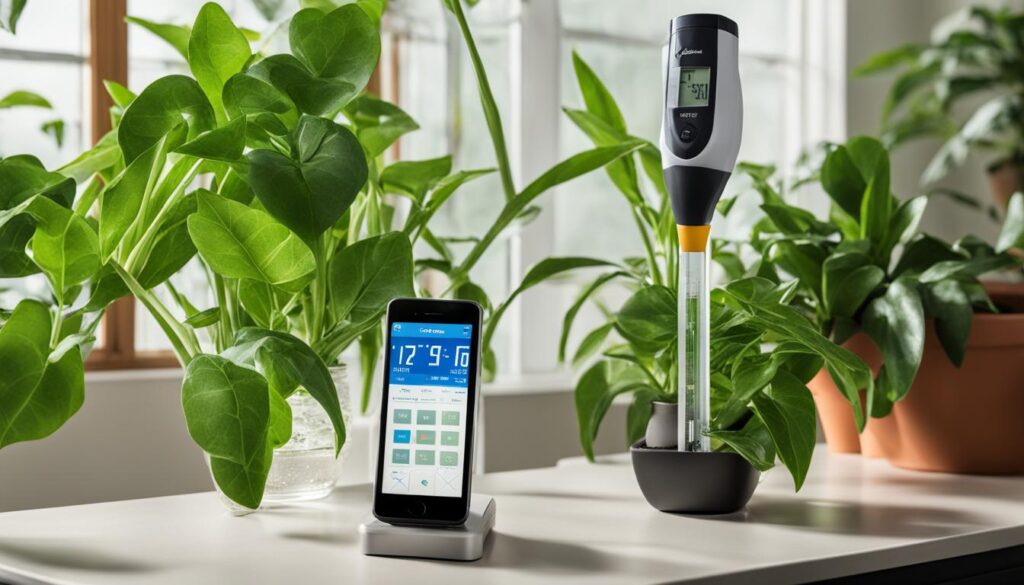
When it comes to ensuring the optimal hydration of your indoor plants, using a moisture meter can be a game-changer.
This handy device provides precise and accurate measurements of the soil’s moisture content, allowing you to water your plants effectively. There are several key benefits to using a moisture meter that every indoor plant owner should know.
1. Avoid Overwatering and Underwatering: One of the biggest advantages of using a moisture meter is that it helps you avoid both overwatering and underwatering your plants.
By providing an instant reading of the soil’s moisture levels, the meter enables you to determine whether your plant needs watering or if it’s already adequately hydrated.
This ensures that you are giving your plants just the right amount of water they need, promoting healthier growth and preventing issues like root rot.
2. Accurate and Scientific Approach: Unlike visual cues or manual checks, a moisture meter provides a scientific measurement of the soil’s moisture content. This eliminates any guesswork and gives you a reliable indication of your plant’s watering needs.
With this accurate information at your fingertips, you can make informed decisions about when and how much to water your indoor plants, resulting in optimal care and healthier foliage.
Maintaining Healthy Soil Moisture Levels
3. Time and Resource Efficiency: Using a moisture meter can help you save time and resources by preventing unnecessary watering. Instead of watering your plants based on a set schedule, you can rely on the moisture meter to determine the actual moisture levels in the soil.
This means you won’t waste water by watering plants that don’t need it, and you won’t risk underwatering by neglecting plants that do. By efficiently managing your watering routine, you can focus your time and resources on other aspects of plant care.
Using a Moisture Meter for Watering
To use a moisture meter effectively, follow these simple steps:
- Insert the probe of the moisture meter into the soil at various locations around the plant, ensuring it reaches the root zone.
- Wait for a few seconds until the meter displays the moisture reading.
- Refer to the moisture meter’s instructions or recommended moisture levels for your specific plants to determine the appropriate action. If the reading indicates dry soil, it’s time to water, while a moist reading means the soil is adequately hydrated.
- Repeat this process regularly or whenever you suspect your plants may need watering.
By using a moisture meter and following the recommended moisture levels for your plants, you can take the guesswork out of watering and ensure optimum care for your indoor plants.
Watering Techniques
Proper watering techniques are essential for maintaining healthy indoor plants. By following these best practices, you can ensure that your plants receive the right amount of water without risking overwatering or underwatering.
Water Thoroughly and Allow Drainage
When watering your indoor plants, it’s important to thoroughly saturate the soil. This means watering until water seeps out of the drainage holes in the pot.
Thorough watering ensures that the entire root system receives moisture and prevents the buildup of salt deposits in the soil.
After watering, allow the excess water to drain out completely. Empty the saucer or basin beneath the pot to prevent water from sitting stagnant, which can lead to root rot. Proper drainage is crucial for maintaining healthy root systems and preventing water-related diseases.
Use Room Temperature Water
Using room temperature water is vital for preventing shock to your plants. Extreme temperatures, either too hot or too cold, can stress the plants and damage their roots. Fill a watering can or container and let it sit at room temperature for a few hours before using it on your plants.
While most indoor plants can tolerate tap water, some sensitive plants may benefit from filtered or rainwater. These sources remove chlorine and other chemicals that can impact plant health. Research the specific needs of your plants to determine if alternative water sources are recommended.
Consider Watering from the Bottom
For plants that prefer to stay dry near their stems, such as succulents, watering from the bottom is an effective technique.
Place the plant pot in a saucer or basin filled with water and allow the plant to soak up water through the drainage holes. Once the top layer of soil is moist, remove the plant from the water and let any excess drain out.
This method ensures that the roots receive moisture without wetting the stems and leaves, reducing the risk of fungal diseases. It’s important to note that not all plants thrive with bottom watering, so research the watering preferences of your specific indoor plants.
| Best Practices for Watering Indoor Plants |
|---|
| Thoroughly water until excess water drains out of the pot |
| Allow the soil to dry slightly between waterings |
| Use room temperature water to prevent shock |
| Consider using filtered or rainwater for sensitive plants |
| Water from the bottom for plants that prefer dry stems |
Considerations for Watering Frequency
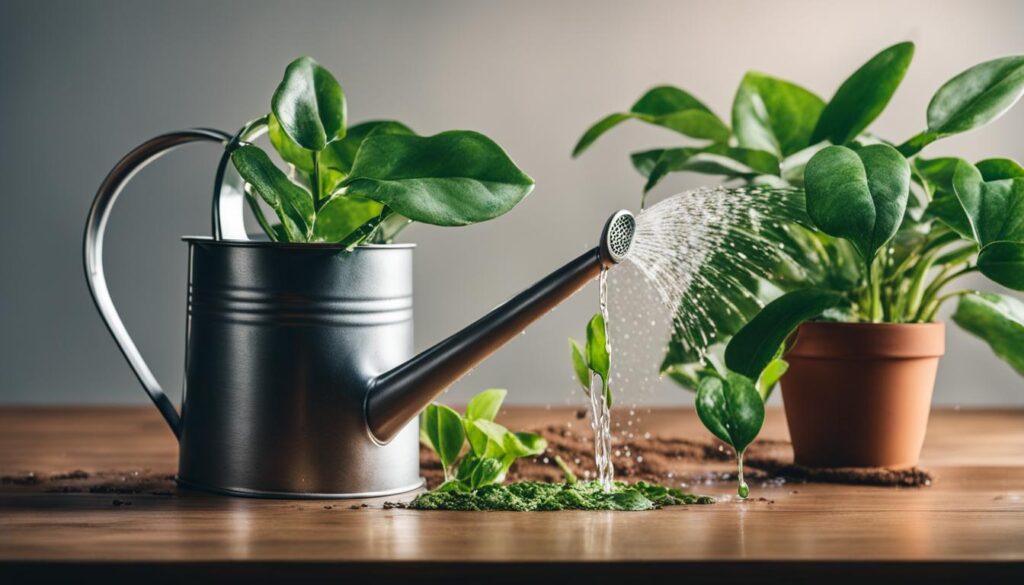
When it comes to maintaining healthy indoor plants, one of the most important factors to consider is the frequency of watering. But, there is no one-size-fits-all answer to the question of how often to water indoor plants.
Various factors play a role in determining the watering needs of each specific plant. By adjusting the watering frequency based on these considerations, you can ensure optimal hydration and overall plant health.
One key factor to consider is the type of plant species you are caring for. Different plants have different water requirements. Some plants, like succulents and cacti, thrive in dry conditions and only need occasional watering.
On the other hand, tropical plants may require more frequent watering due to their preference for high humidity. Researching the specific watering needs of each plant species will help guide you in determining the appropriate watering frequency.
Another factor to consider is the potting medium and pot size. Plants in smaller pots generally require more frequent watering as they have less soil volume to hold moisture.
Plants in well-draining potting mediums may also need more frequent watering as water drains quickly through the soil. Conversely, plants in larger pots or those with water-retaining potting mediums may require less frequent watering.
Lastly, environmental conditions such as temperature, humidity, and air circulation can impact the watering needs of indoor plants. During hot and dry weather, plants may require more frequent watering to prevent dehydration.
Similarly, plants in rooms with low humidity levels may need additional watering to compensate for moisture loss. Pay attention to the conditions in which your plants are situated and make adjustments to the watering frequency accordingly.
Adjusting the watering frequency of indoor plants is crucial for maintaining their health and well-being. Consider the type of plant species, potting medium, pot size, and environmental conditions when determining how often to water.
Research the specific watering needs of each plant and make adjustments accordingly. By providing appropriate hydration, you can ensure your indoor plants thrive and flourish.
Timing and Temperature Considerations
When it comes to watering indoor plants, timing and temperature play a crucial role in maintaining their health and vitality. Understanding the best time to water and the impact of water temperature can greatly contribute to the overall well-being of your plants.
For indoor plants, it is generally recommended to water them in the morning. This allows excess moisture on the leaves and soil surface to evaporate throughout the day, reducing the risk of fungal diseases and providing optimal growing conditions.
Watering in the morning also allows the plants to absorb the water during the day, when they are actively photosynthesizing and growing.
Additionally, the temperature of the water you use can affect the health of indoor plants. It is important to use room temperature water, as extremes in temperature can shock the plants and cause damage.
Chlorinated tap water is generally safe for most plants, but if possible, filtered or rainwater may be even better, as they lack the chemicals that can accumulate in tap water over time.
Recommended Watering Time for Common Indoor Plants
| Plant Species | Recommended Watering Time |
|---|---|
| Snake Plant | Morning |
| Pothos | Morning |
| Spider Plant | Morning |
| Peace Lily | Morning |
| ZZ Plant | Morning |
By following the recommended watering time and using room temperature water, you can provide the optimum conditions for your indoor plants to thrive. Remember to always consider the specific needs of each plant species and adjust your watering routine accordingly.
Troubleshooting Overwatering and Underwatering
Overwatering and underwatering are common issues faced by indoor plant owners. It’s vital to recognize the signs of overwatering to prevent plant damage. When indoor plants receive too much water, their leaves may turn yellow or show signs of wilting.
Over time, the roots can become waterlogged, leading to root rot and the growth of harmful fungi. To avoid overwatering, it’s important to allow the soil to dry out between waterings and ensure proper drainage in the plant’s container.
On the other hand, underwatered plants can suffer from dry and brittle foliage. If you notice your indoor plants are not getting enough water, one effective way to revive them is to adjust your watering habits.
Depending on the plant species, you may need to increase the frequency or amount of water you provide. Also, it may be helpful to group plants together to create a more humid microclimate or use a humidifier in the room where your plants are located. This will provide them with the moisture they need to thrive.
Reviving underwatered plants can take time, so be patient and consistent with your watering routine. It’s crucial to find the right balance and avoid oscillating between overwatering and underwatering.
Remember to closely monitor your plants’ behavior and adjust your watering practices accordingly. By troubleshooting these issues and providing the appropriate care, you can ensure the long-term health and vitality of your indoor plants.
FAQ
What are the signs that an indoor plant needs water?
Signs that an indoor plant needs water include dry soil, drooping or wilted leaves, lighter soil color, and signs of dehydration such as curling or browning leaf edges.
What is the importance of proper watering for indoor plants?
Proper watering is crucial for the health and well-being of indoor plants. Overwatering can lead to root rot and other diseases, while underwatering can cause dehydration and stunted growth.
How can I check the moisture levels of my indoor plants?
You can check the moisture levels of indoor plants by sticking your finger 2-3 inches deep into the soil or using a soil stick or wooden dowel. Drooping leaves or lighter soil color may also indicate the need for watering.
How can I observe my plant’s behavior to determine its watering needs?
Paying attention to your plant’s behavior can provide valuable insights into its watering needs. Wilted or drooping leaves, lighter soil color, and signs of dehydration such as curling or browning leaf edges may indicate the need for water.
How can I use weighing and lifting techniques to assess watering needs?
By lifting the plant pot, you can gauge its weight and determine if watering is necessary. A dry plant will feel lighter, while a well-watered plant will be heavier. This technique is especially useful for larger pots and plants that cannot be easily reached for other methods of assessment.
How can I use moisture meters to measure soil moisture levels?
Moisture meters provide a scientific and accurate way to measure soil moisture levels. These meters are inserted into the soil, and the reading indicates the moisture content. This method is particularly useful for those who want a precise measurement of their plant’s watering needs.
What are the proper watering techniques for indoor plants?
The best approach is to thoroughly saturate the soil with room temperature water, allowing excess water to drain out of the pot’s holes. Watering from the bottom using a saucer or basin is also effective for plants that don’t like moisture near their stems.
How often should I water my indoor plants?
The frequency of watering indoor plants depends on factors such as plant species, potting medium, environmental conditions, and pot size. It is important to understand the water needs of each specific plant and make adjustments accordingly.
When is the best time to water indoor plants?
It is generally recommended to water indoor plants in the morning, allowing excess moisture to evaporate throughout the day. Using room temperature water is crucial, as extremes can damage the plant. Chlorinated tap water is usually safe, but filtered or rainwater may be even better.
How can I troubleshoot overwatering and underwatering issues?
Signs of overwatering include yellowing leaves, root rot, and fungal growth. Underwatered plants may exhibit dry and brittle foliage. Adjusting watering habits and providing appropriate moisture can help revive underwatered plants and prevent damage from overwatering.

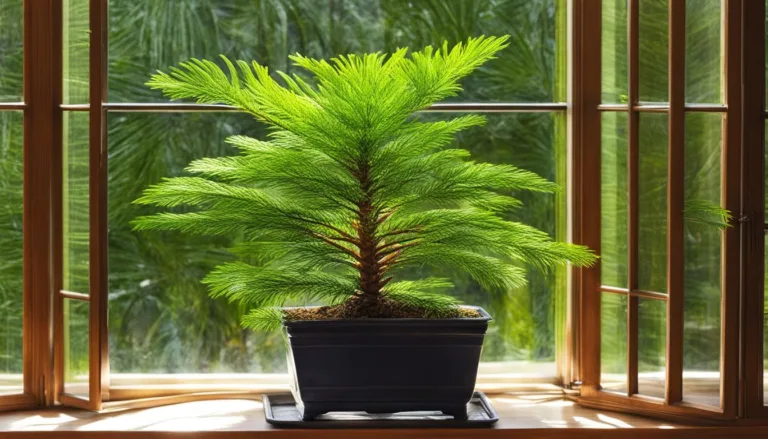
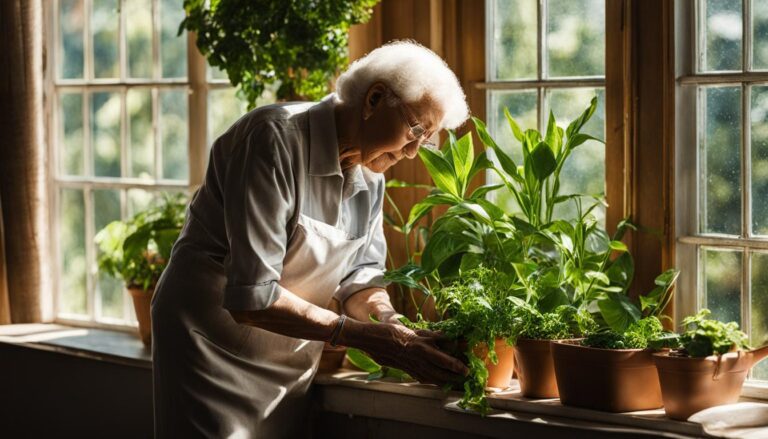
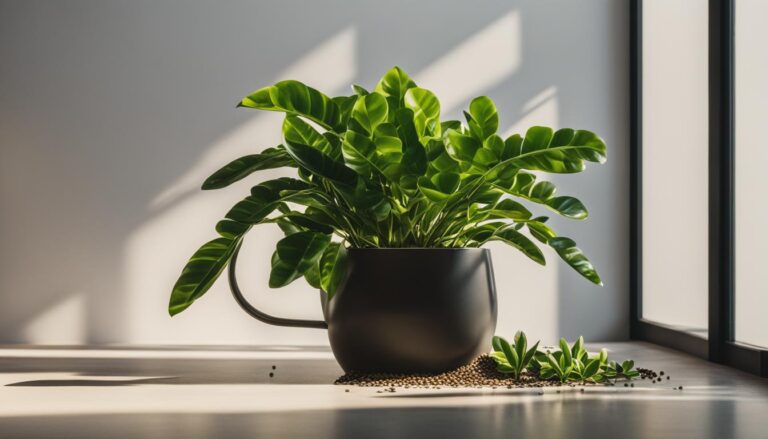
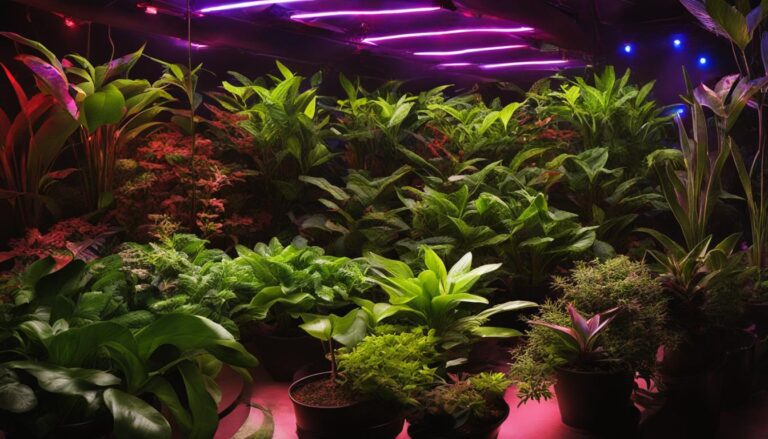

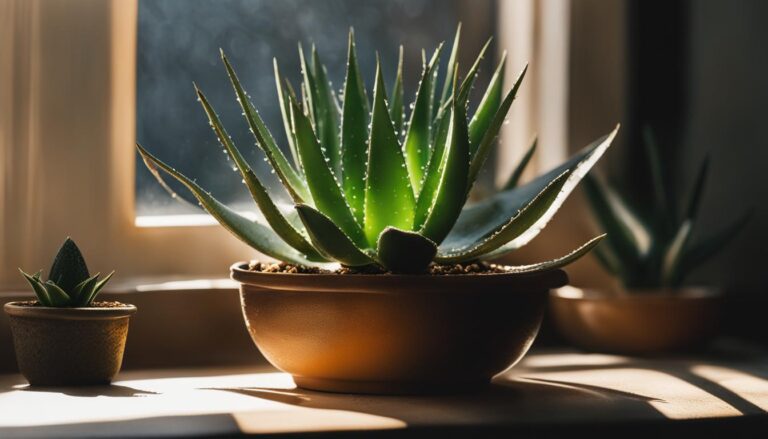
2 Comments
Comments are closed.